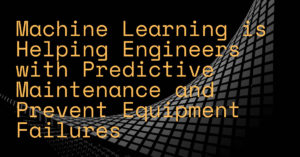
The need of assuring equipment dependability increases as companies increasingly rely on automation and digitization.
Downtime, decreased production, and higher expenditures are all possible outcomes of equipment failure. Engineers, however, are finding that machine learning may help them foresee and even avoid equipment breakdowns.
You probably already know that machine learning is a branch of Artificial Intelligence that allows computers to automatically learn from data in order to perform tasks such as prediction or action.
In this piece, we’ll take a look at how machine learning is being used to foresee and avoid machine breakdowns.
Understanding Equipment Failures
When machinery or other apparatus quits doing what it’s supposed to, we call that a failure. Many factors, including normal use and age, faulty construction, and the natural environment, might contribute to this.
When machinery breaks down, the results can vary from a slight nuisance to massive disasters including human injury, property damage, and even the destruction of ecosystems.
Machine Learning, Equipment Failures and Predictive Maintenance
Predicting and avoiding equipment breakdowns is becoming increasingly dependent on machine learning.
Machine learning algorithms may be trained using the massive volumes of data produced by contemporary technology and machinery to detect patterns and anomalies that may warn of an approaching breakdown.
These algorithms can then alert engineers to potential failures before they happen.
Machine Learning Techniques for Predictive Maintenance
There are several techniques used in machine learning to predict equipment failures, including:
Anomaly detection: Anomaly detection is the process of looking for and analyzing unusual occurrences that might signify trouble. A rise in operating temperature, for instance, may signal the imminence of a breakdown in a piece of machinery.
Time-series forecasting: Time-series forecasting is a method of making predictions about the future by analyzing patterns in the present. For instance, if a piece of machinery has a history of failing at predictable intervals, the next failure may be predicted using a machine learning algorithm.
Prognostics and health management: Machine learning methods may be used to estimate how long various pieces of machinery will continue to function effectively. Engineers can avoid costly breakdowns by keeping tabs on machinery in real time and acting before it becomes too damaged to be repaired or replaced.
Advantages of using Machine Learning in Equipment Failure Prediction
Using machine learning in equipment failure prediction offers several benefits, including:
- Increased accuracy and reliability: Machine learning algorithms can analyze vast amounts of data, allowing for more accurate predictions than traditional methods. Algorithms developed through machine learning can sift through mountains of data to make more precise forecasts than human experts ever could.
- Early warning and proactive maintenance: By providing early warning signs of impending failures and malfunctions, machine learning allows engineers to take proactive steps to prevent the failure from occurring.
- Cost savings and improved efficiency: By preventing equipment failures, machine learning can save industries time and money by reducing downtime and increasing productivity.
Challenges and Limitations to Monitoring Equipment with Deep Learning
While machine learning has proven to be a valuable tool in predicting and preventing equipment failures, there are still several challenges and limitations, including:
- Data availability and quality: It’s essential to collect data for training machine learning algorithms. This information has to be readily accessible in sufficient numbers for the algorithms to learn properly.
- Complexity of machine learning algorithms: Algorithms for machine learning can be complicated and challenging to implement, necessitating specific knowledge and skills.
- Integration with existing systems: For machine learning algorithms to be useful, they must be incorporated into pre existing infrastructure and procedures.

